June 7 Archaia Korinthos (Day 254)
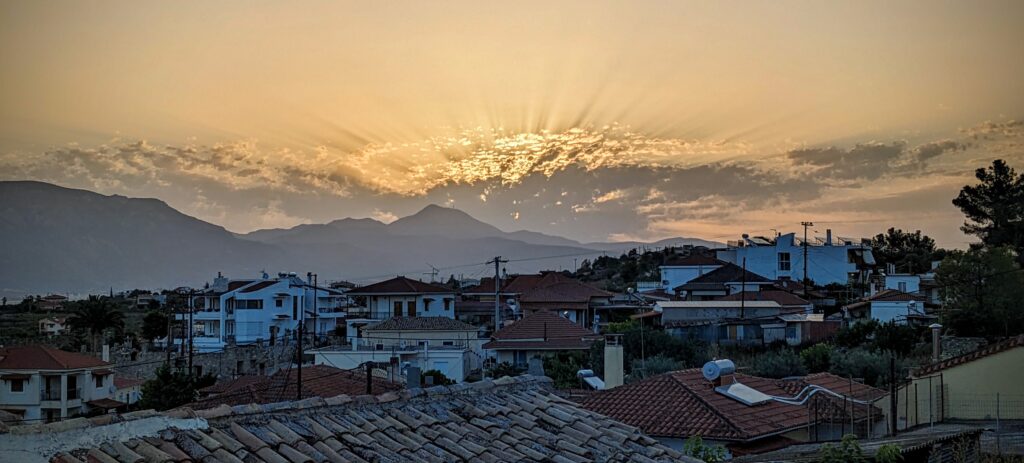
A beautiful sunrise over the mountains!
Today we will cross the street and visit the Archaeological Museum of Ancient Corinth, an open air museum we can see from our Airbnb! We got there after breakfast and meandered around until we went into the Museum which we did not know was there. In a courtyard a young woman Archaeologist was manning a display of the work being done at the site, work that has been ongoing for 140+ years by the American School of Classical Studies at Athens! She was a font of interesting information and piqued our curiosity!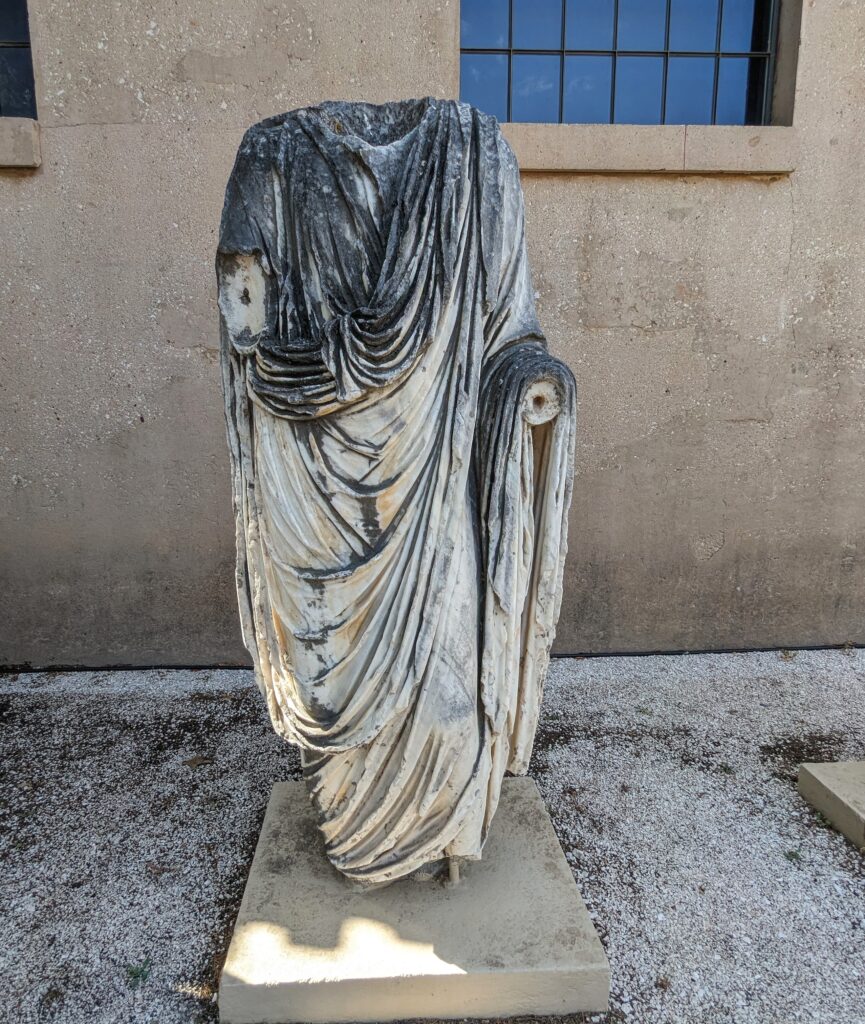 First off she explained the propensity of headless, armless statues! Wear and tear of course, the neck and arms being weak points in sculpture, easily fractured, and the fact that they made the statues en masse, to be interchangeable! The heads were sculpted separately to match the subject, and the arms could be holding different objects; law books, scrolls, wreathes, etc.!
First off she explained the propensity of headless, armless statues! Wear and tear of course, the neck and arms being weak points in sculpture, easily fractured, and the fact that they made the statues en masse, to be interchangeable! The heads were sculpted separately to match the subject, and the arms could be holding different objects; law books, scrolls, wreathes, etc.!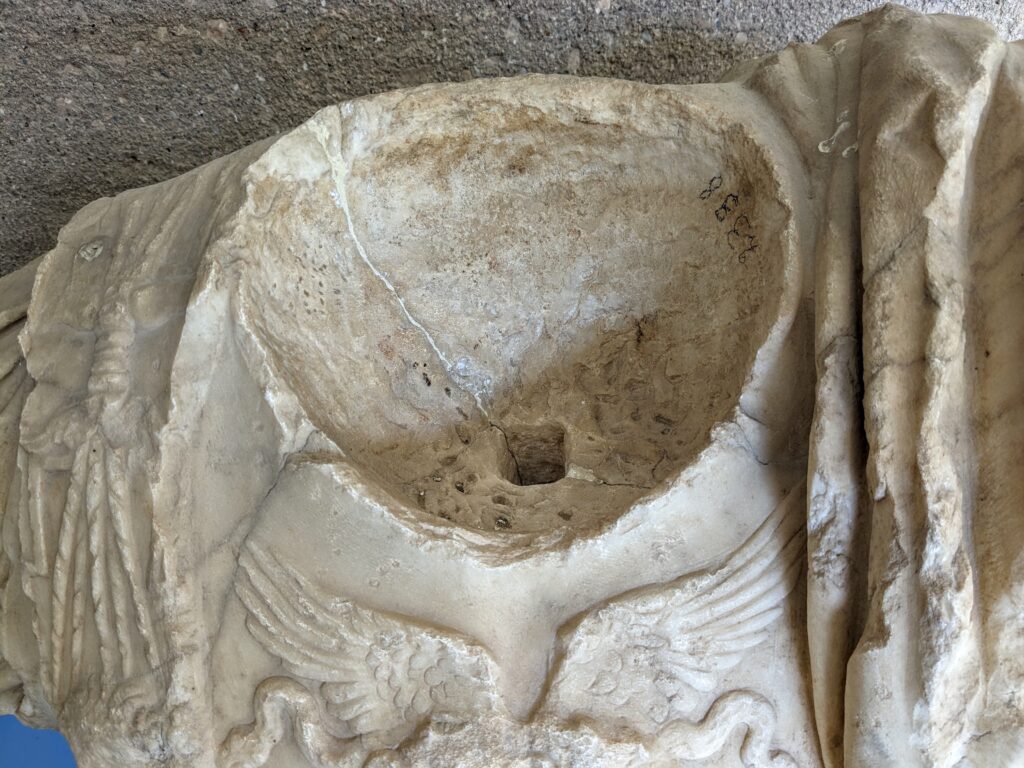 Another statue showing the insert for the appropriate head!
Another statue showing the insert for the appropriate head!
She went on describing the archaeological work being done by academics from various institutions that sometimes bring to light the everyday lives of the inhabitants of Ancient Corinth! For examples;
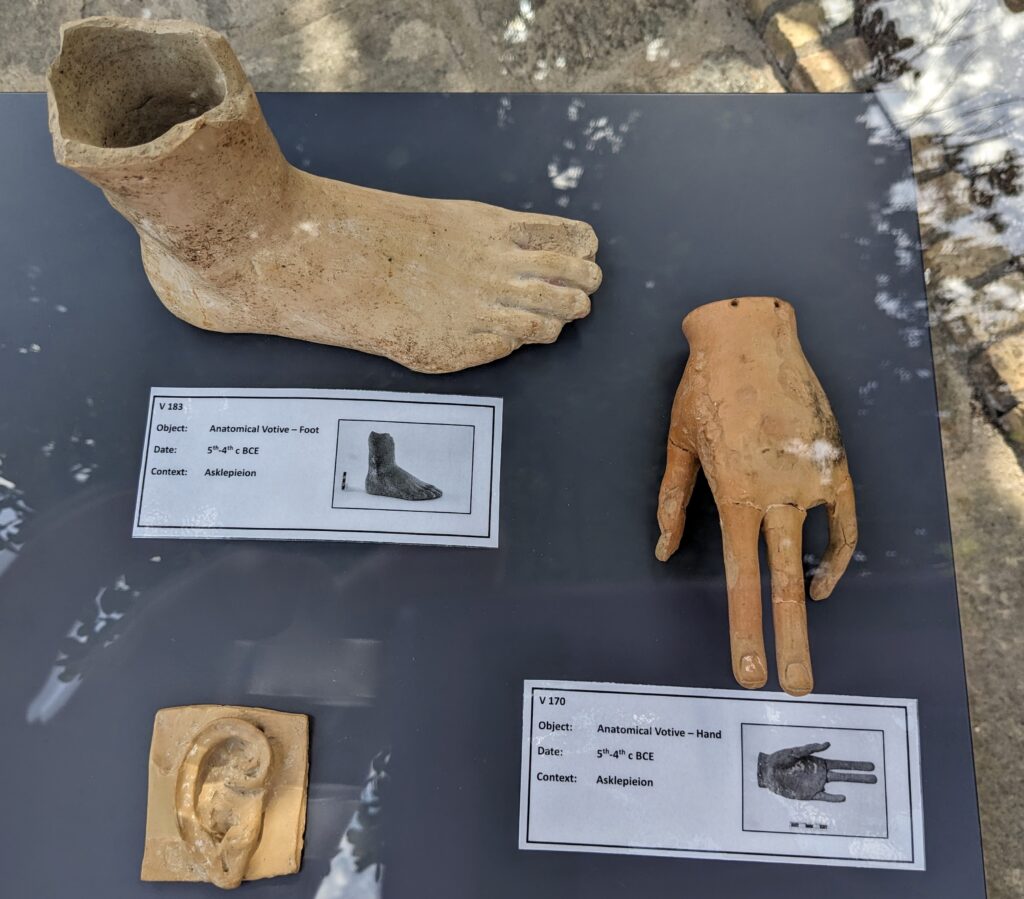
The many figurines and sometimes life size statuary of body parts found in the temples dedicated to the Gods of healing (sort of like ancient hospitals) that were used to invoke the Gods to heal said body part, or to thank the Gods for successful healing. The Priests or Acolytes of the temple gave prescriptions or prayers and sometimes even performed surgery to assist the Gods in the healing process!
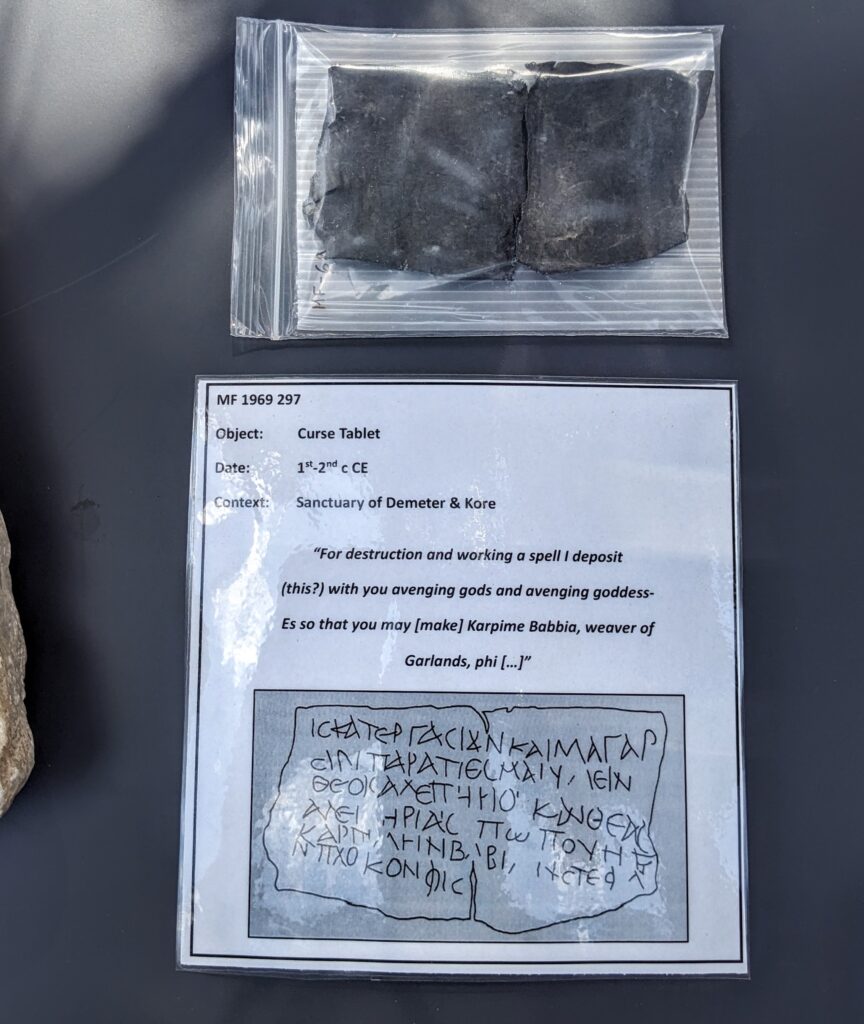
The lead tablets that were inscribed with curses, found in the vaults of some temples. There was a brisk business for inscribing the thin lead plates with specific curses against specific persons and the punishments the wronged wanted inflicted on the cursee! There were several plates targeting one particular seller of garlands from different people! What did that person do to warrant so many curses against them?
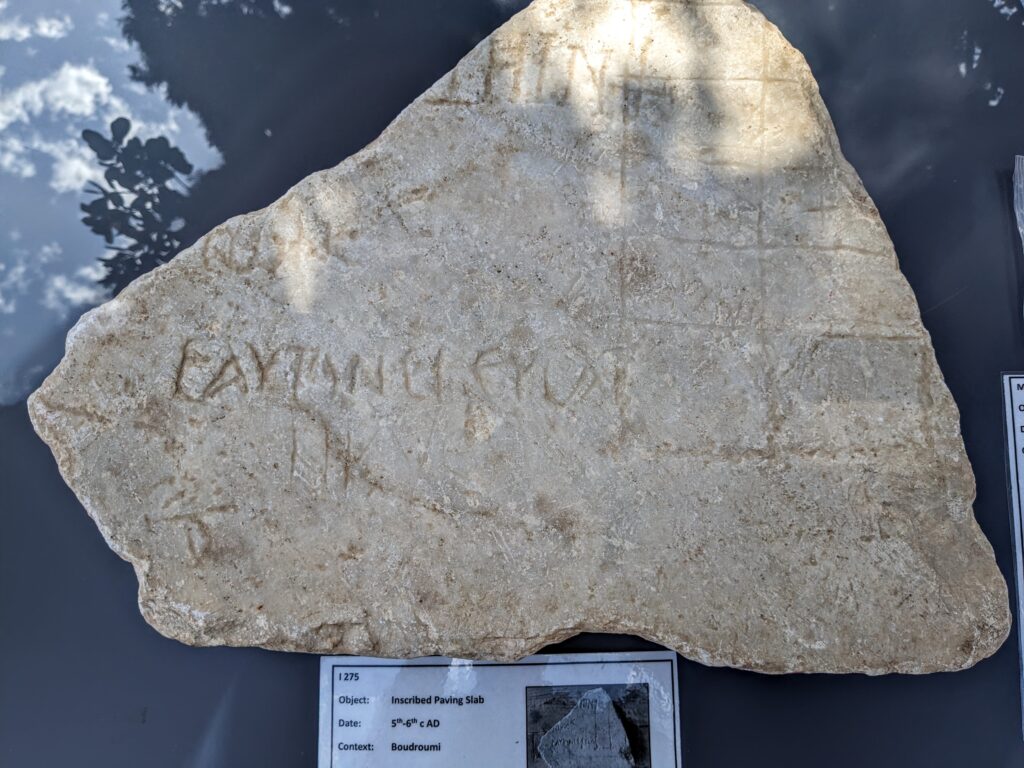
The floor flagstone found in what was first thought to be a workshop, but determined, by the inscriptions carved into the stone, to be a jail cell! The carving revealed that the jailed felt wrongly accused and convicted (that never changes!) and the boredom of jail, with a boardgame carved into the floorstone of the cell! The cell had probably been a dirt floored workshop or retail shop but was repurposed in a later era as a jail cell that for obvious reasons would need a solid floor, hence the floorstone!
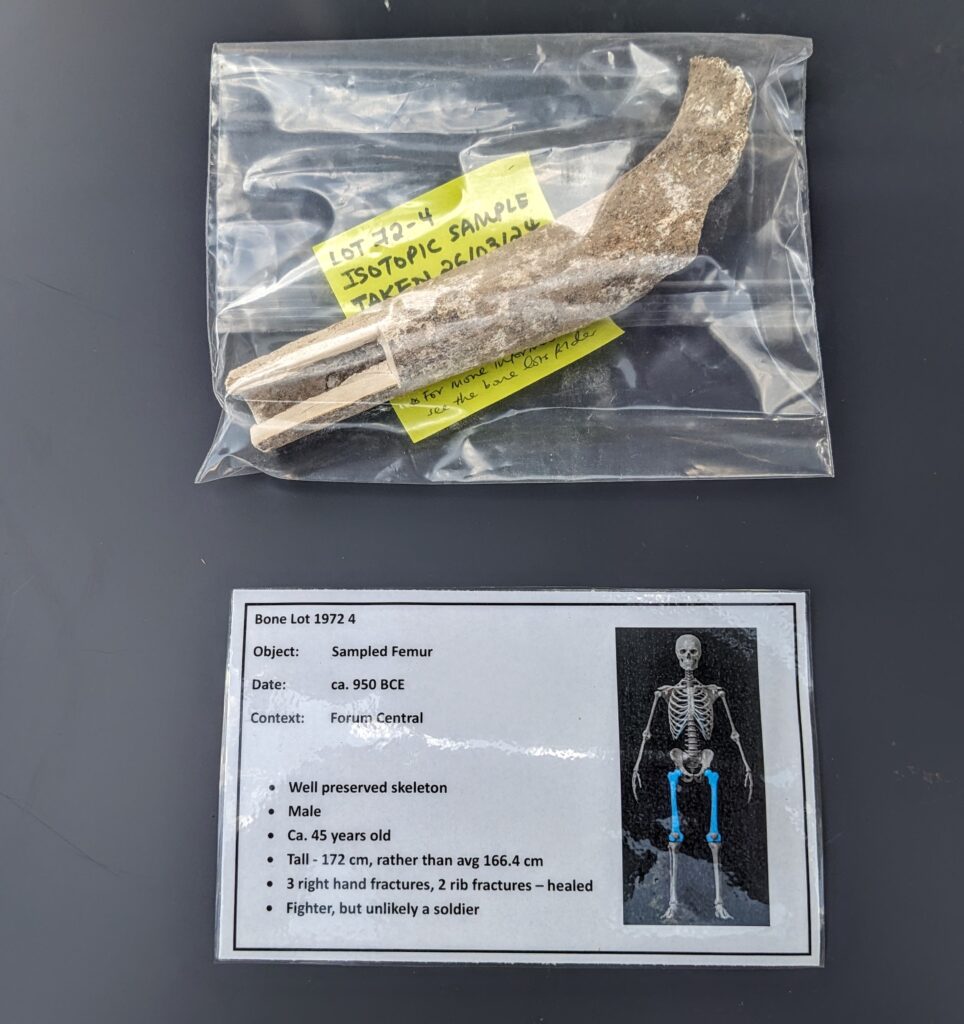
The skeletal remains found in cemeteries, through forensic analysis, have brought to light many aspects of the lifestyles of the inhabitants through the centuries. The fact that these remains bore evidence of healed fractures of the hand and ribs indicate he may have been a fighter, but not a soldier. A soldier would have injuries of the face and head that would likely have killed him!
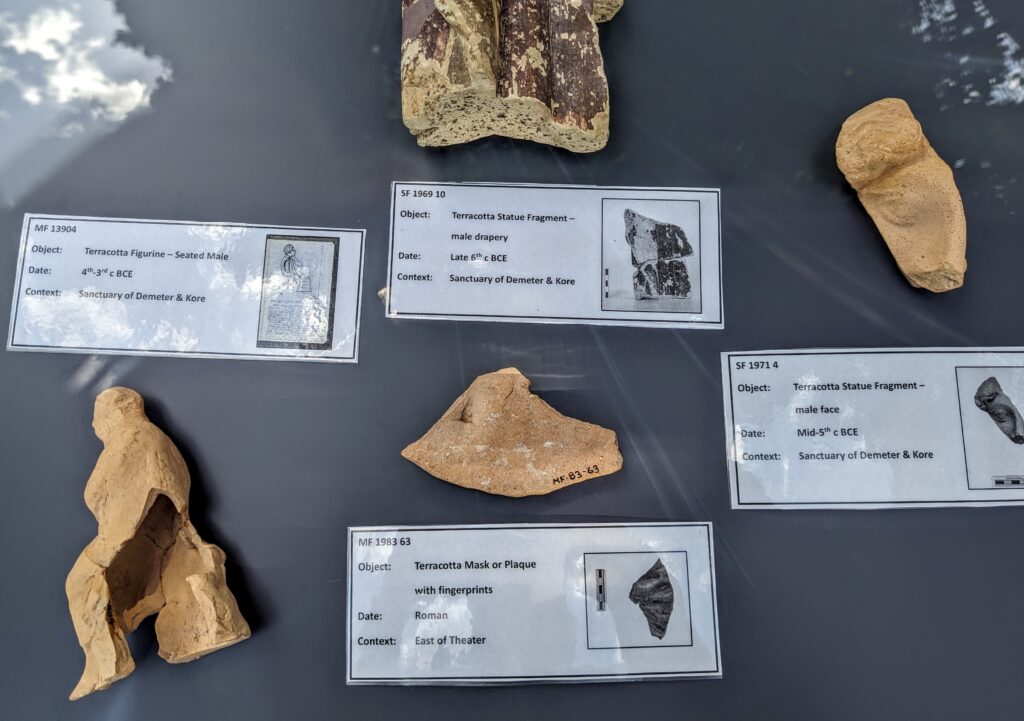
The mass production of clay figurines for temple worship, funerary gifts, household altars, and even toys was thought to be manufactured mostly by men. Study of the fingerprints embedded in the clay by researchers collaborating with the FBI has revealed that women and even children were active in the business!
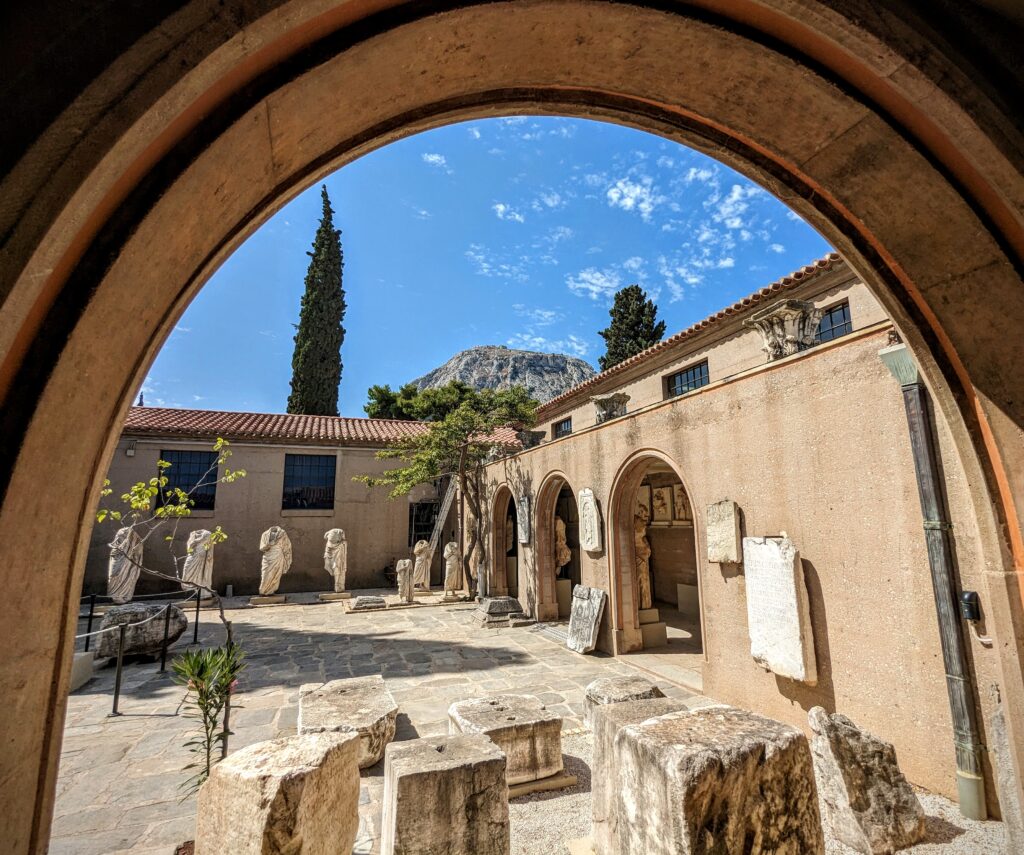
The halls surrounding the courtyard contain many artifacts discovered in the ruins of the ancient city. Spanning time from the Neolithic Period 6,500 B.C. to the present! Greek, Roman, Byzantine, Frankish, Venetian, Ottoman, Modern, all layered on top of each other!
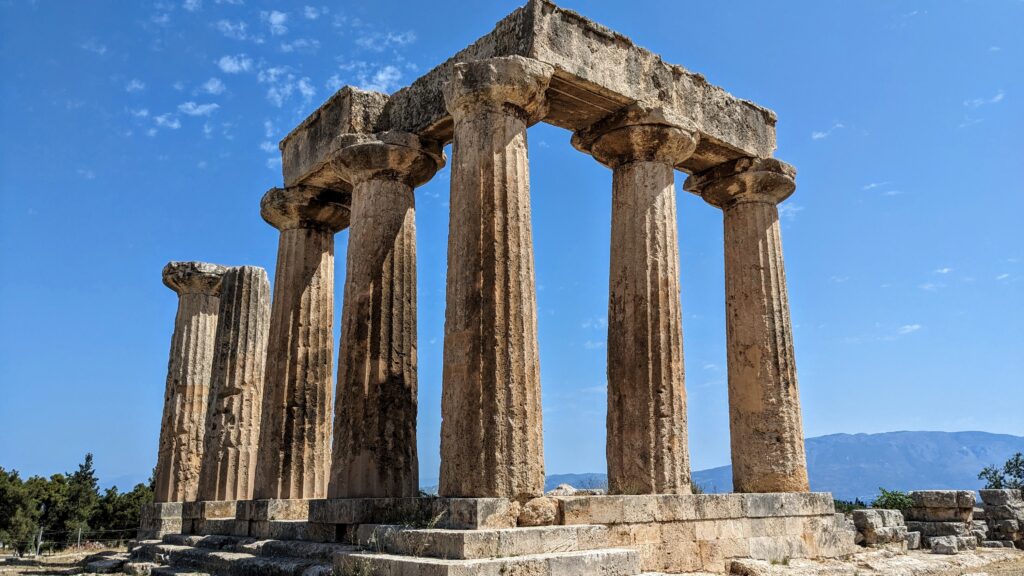
Outside, the many acres that have been excavated reveal temples, marketplaces, amphitheaters, baths, paved roads and pavilions, too much to take in! Dominating it all are the columns of the Temple of Apollo! Greek or Roman? The history is so long and complex it boggles me!
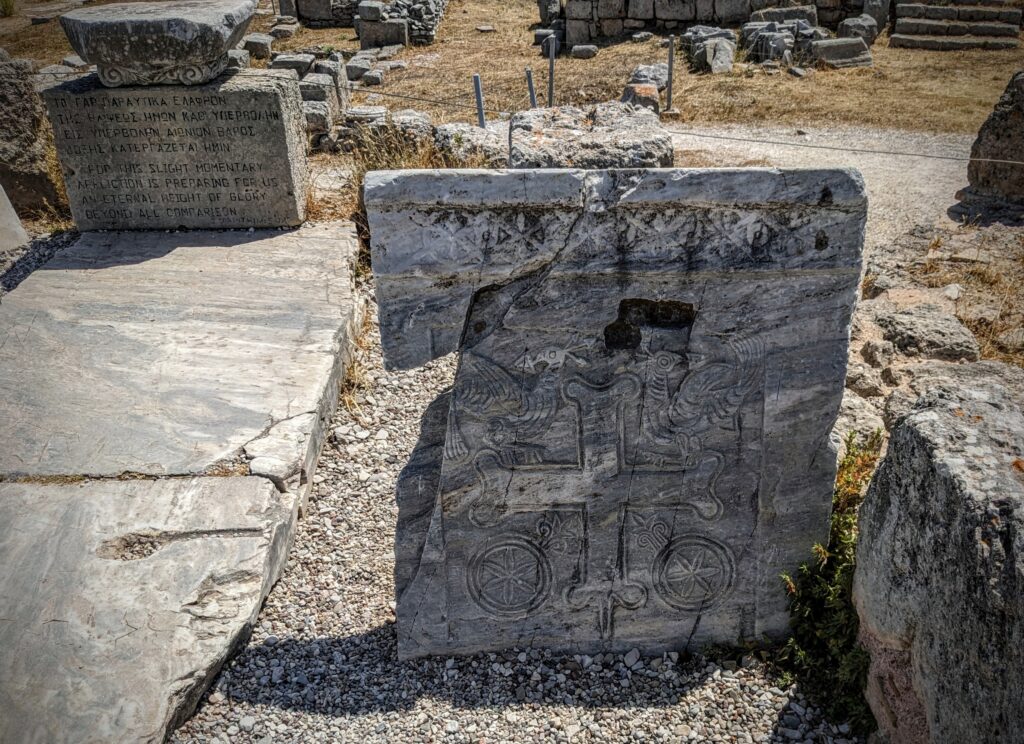
Throw in the Christian aspect and another layer is slathered on! This is the site where the Apostle Paul was put on trial and acquitted of “conducting illegal teachings”.
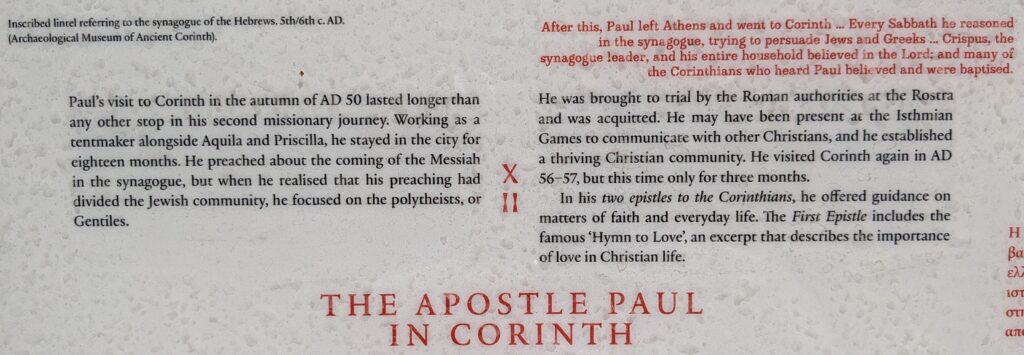
“And the rest is history”!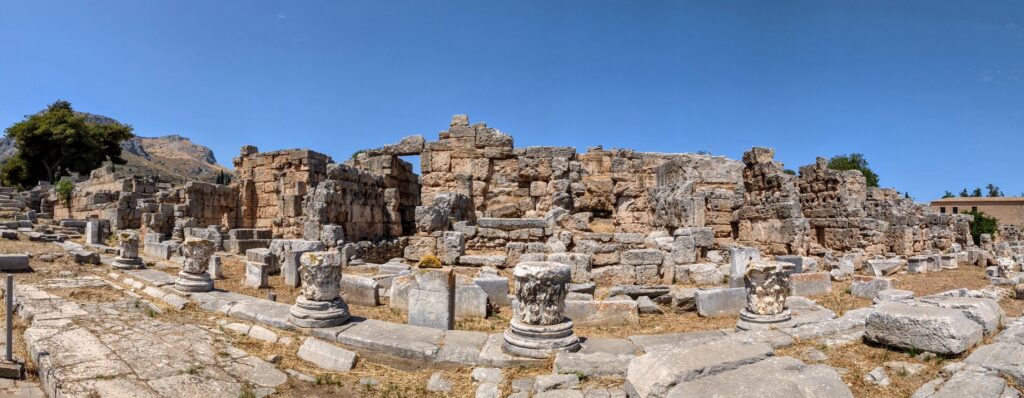
June 6 Ferry to the Mainland (Day 253)
We’re moving on from the islands to the mainland today. Our Seajet fast catamaran ferry will take us directly from Syros to Piraeus, the major port to Athens. We had a few hours in the morning before we boarded so we wandered around town a little bit.
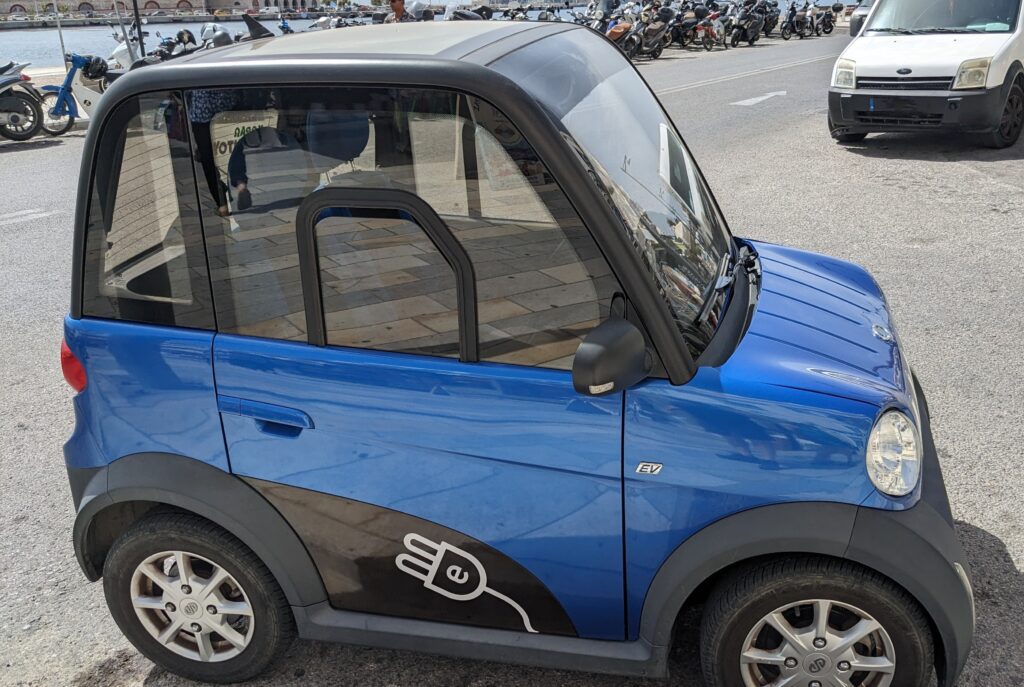
The cutest little electric car! Great for an island mode of transport!
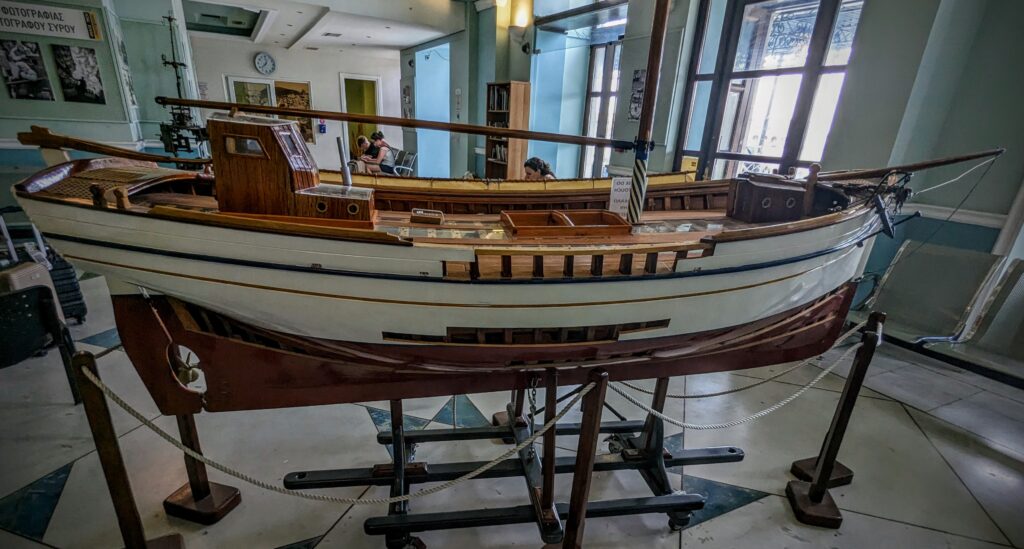
In the port waiting room this scale model shows the most common mode of inter-island transport of the 19th & early 20th century!

Our ferry was about 20 minutes late, and we took off, trying to make up time! We headed into cloudy weather with a little sprinkle of rain. Unfortunately it didn’t break the hot spell!
When we arrived at Piraeus, a suburb of Athens, we hiked the 15 minutes to the train station. When we got there we were told it’s the wrong station! Those trains only went to Athens, we’re heading west to Korinthos (Corinth). Luckily that station is only a block away!
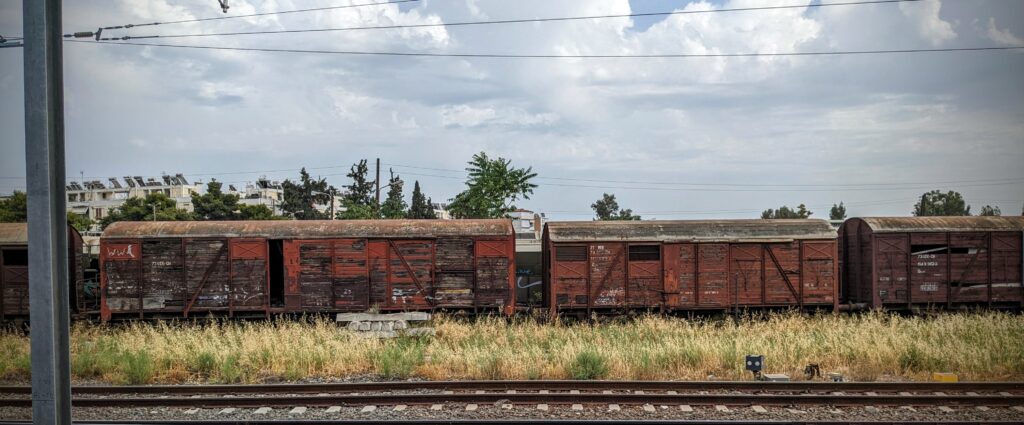
We got the feeling we’re heading into the hinterlands! Not the metropolis of the Acropolis! Which is fine with us!
We arrived at the Korinthos station and had a taxi waiting for us to take us to Archaia Korinthos (“Ancient” Korinthos). Corinth in English, Korinthos (Κόρινθος) in Greek!
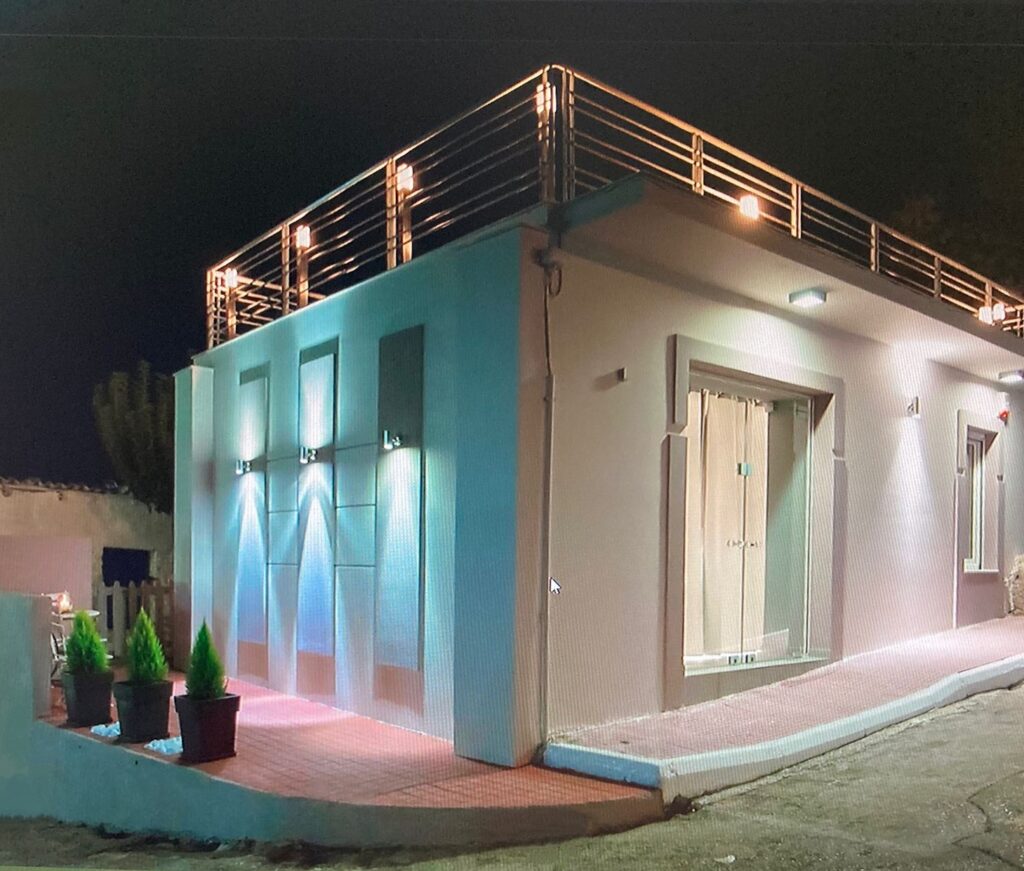
An older Airbnb picture of our accomodation, We arrived before dark and were greeted by our host’s father who gave us a tour and we settled in.
We of course went up to the rooftop terrace and got some pictures!
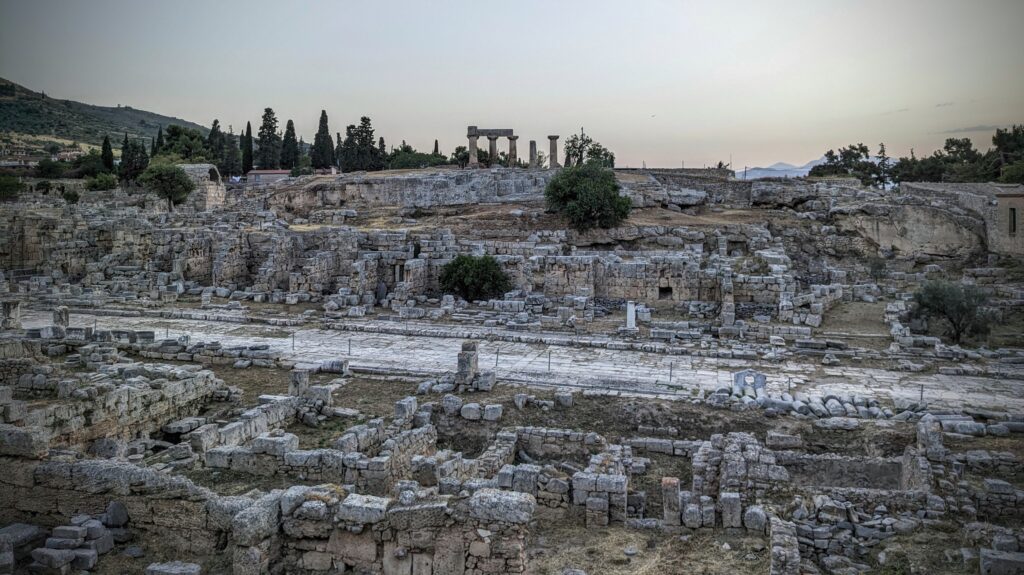
The archaeological site of the ancient city is steps away!
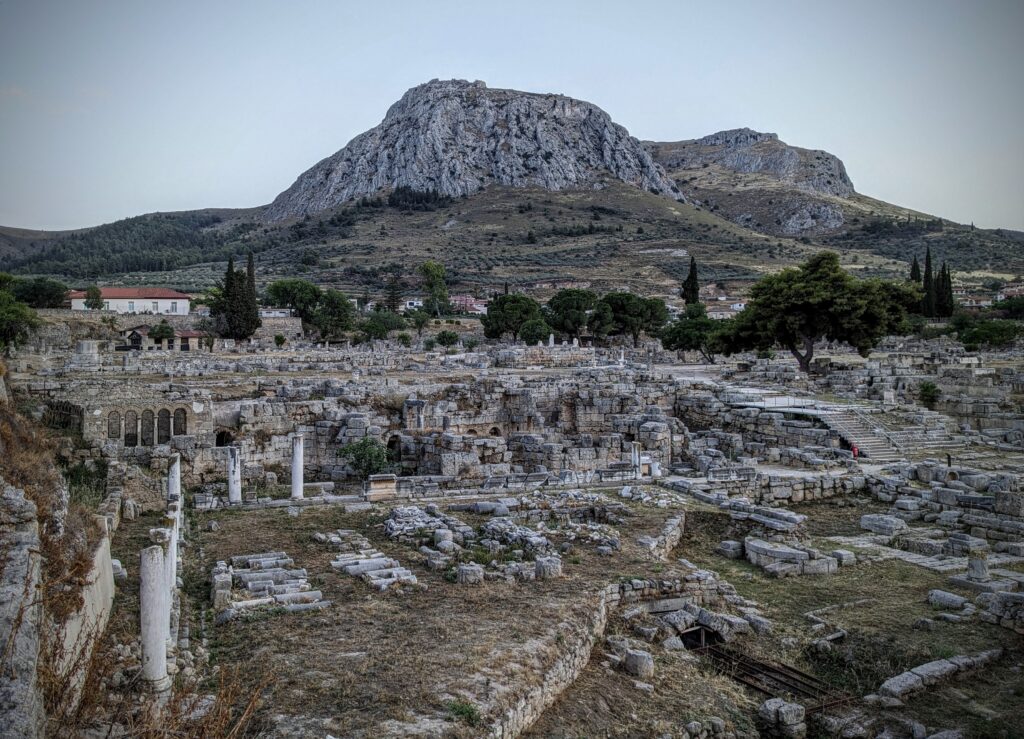
Overlooking the village is Acro Corinth (“High” Corinth) on the top of the distant hills.
We walked through the tiny village and found a pizza parlor and had dinner.
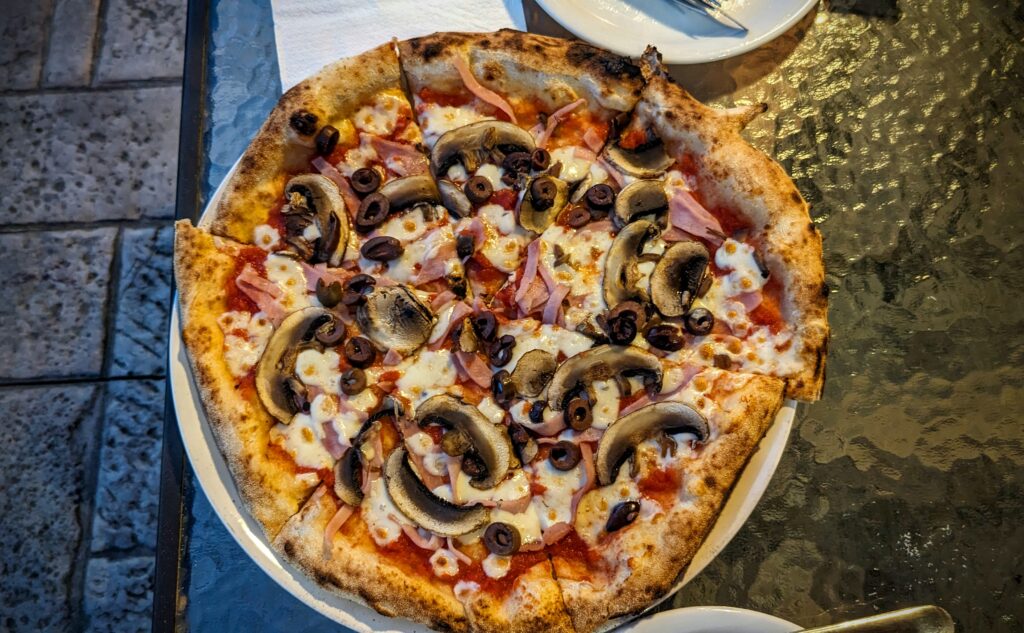
We had a fantastic salad first, then the pizza!
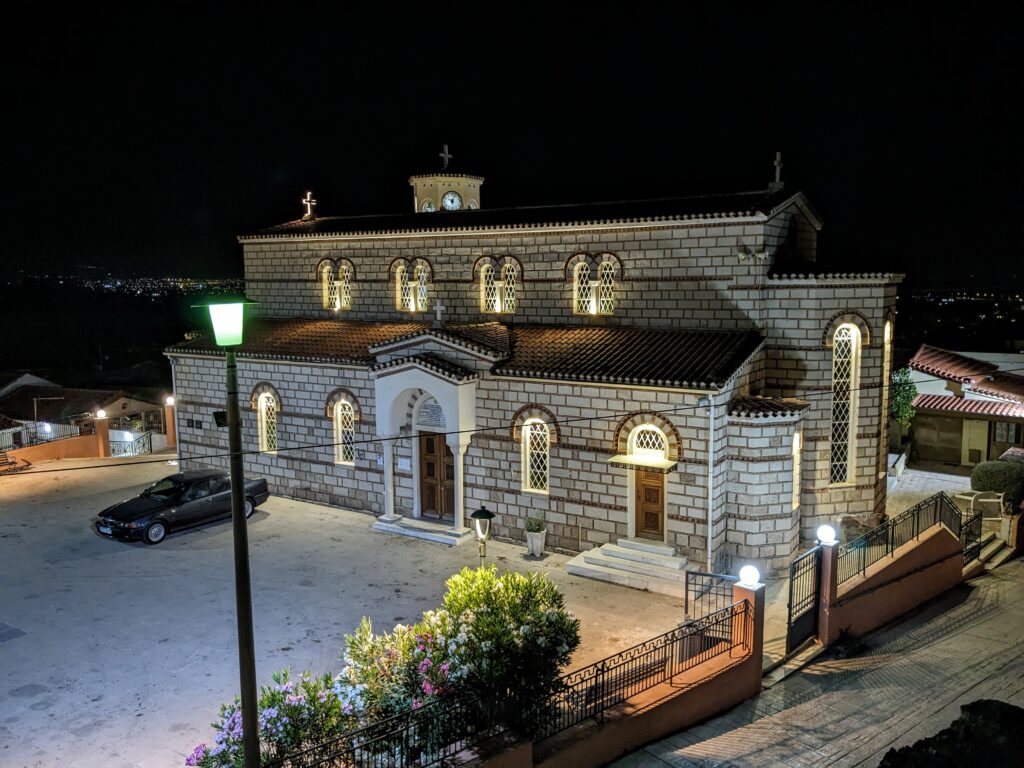
We had nightcaps of wine on the rooftop terrace, looking down on the Greek Orthodox Church just across the street!
June 5 Last Night (Day 252)
We spent the day relaxing and keeping cool, organizing and packing for our next move. In the cool of the evening we headed out.
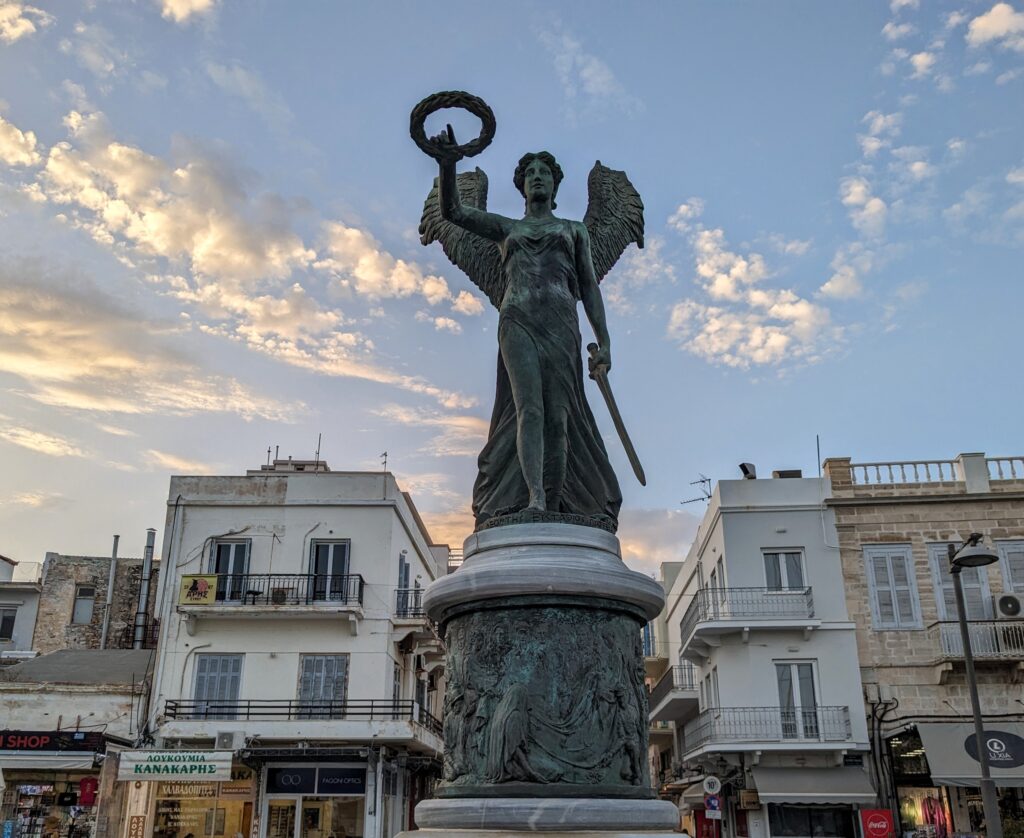
The National Resistance Monument “depicts a grandiose statue of Nike holding a wreath of victory and a large sword! It symbolizes the fight of the Greeks against their conquerors during the Second World War.”
We found an open air restaurant along the waterfront not far from the statue to enjoy the slightly cooler breeze while we had our last dinner in Syros. From our rooftop terrace we watched the luxury yachts come and go.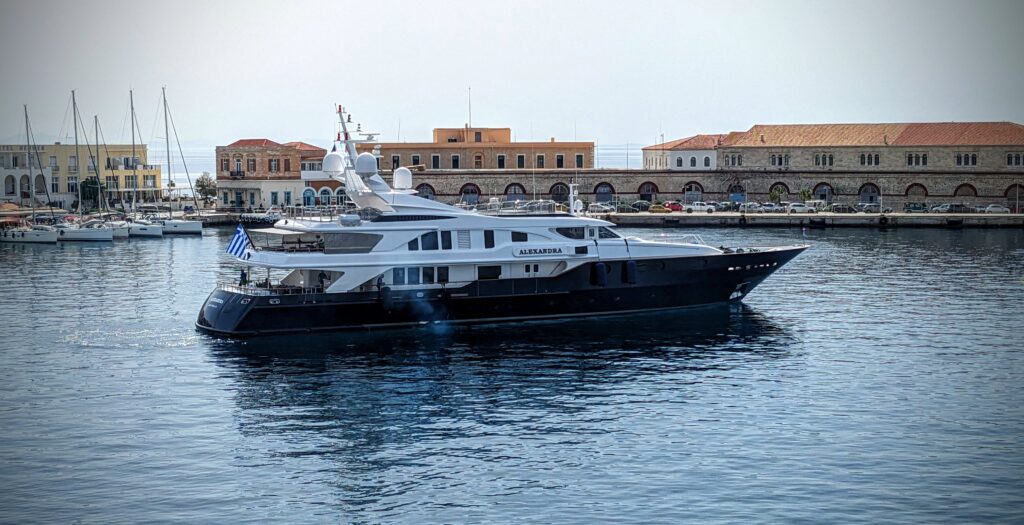 The Alexandra Yacht left at about 10am this morning. Replaced by the O’Pari Yacht, at about 10pm! Too big to get in one photo!
The Alexandra Yacht left at about 10am this morning. Replaced by the O’Pari Yacht, at about 10pm! Too big to get in one photo!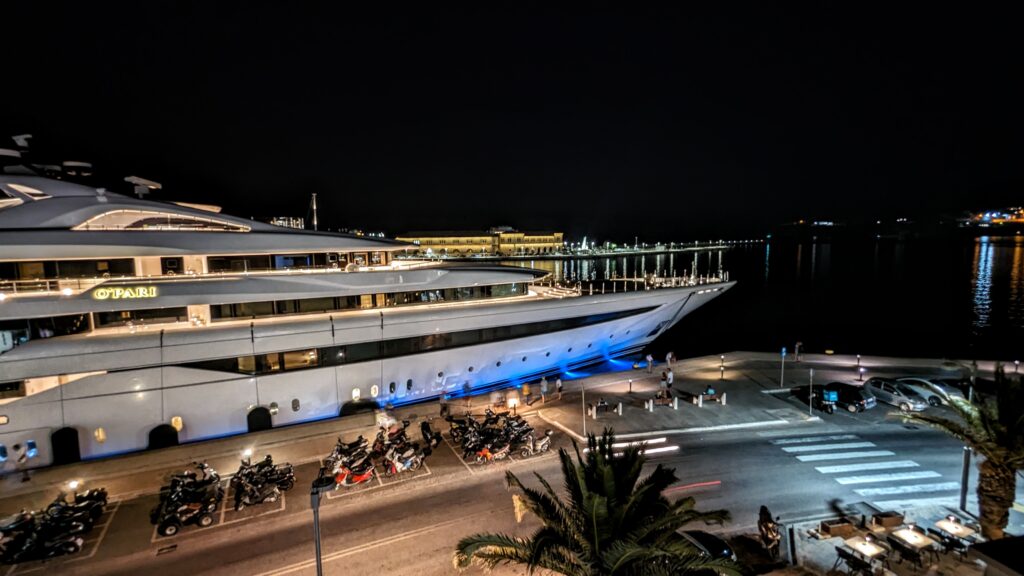
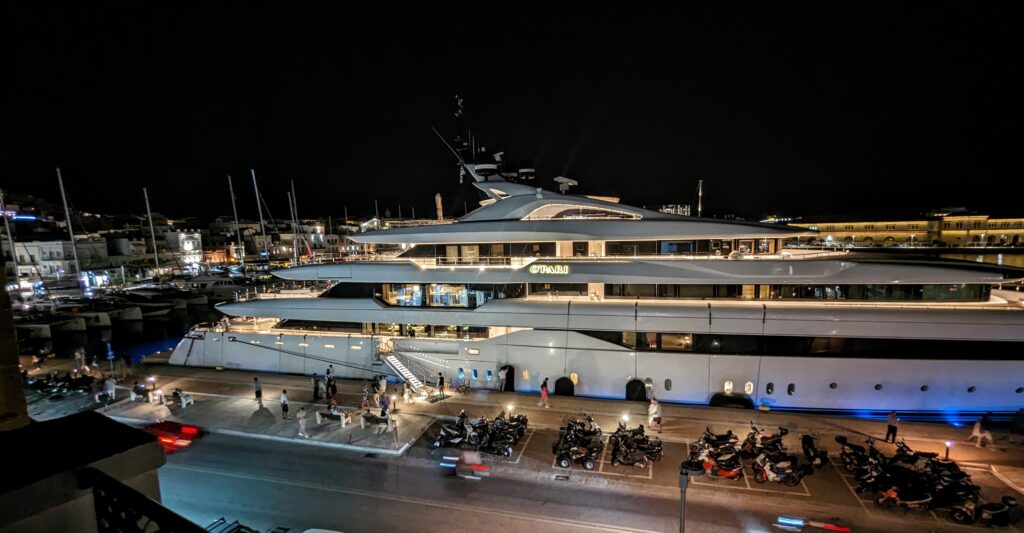 That was some interesting people watching!
That was some interesting people watching!
June 4 Ano Syros (Day 251)
I set out on a trek this morning, navigating the narrow lanes of the ‘new’ town and found the way to the narrower, steeper lanes of the ‘old’ town!
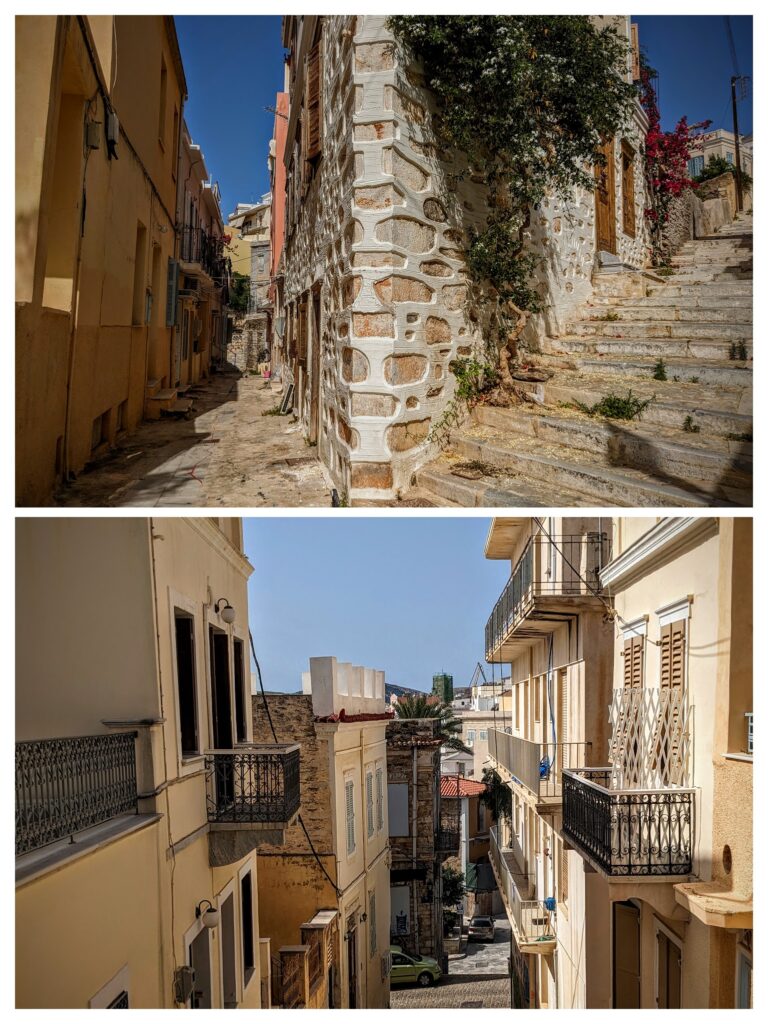
Which way to go? Default to going uphill!
Ano Syros, or “upper” Syros is a medieval city established by Venetians in the 1100’s, on the hill behind the newer town of Ermoupolis. It was a fortified city on the top of the hill, crowned with Saint George Cathedral, my goal this morning.
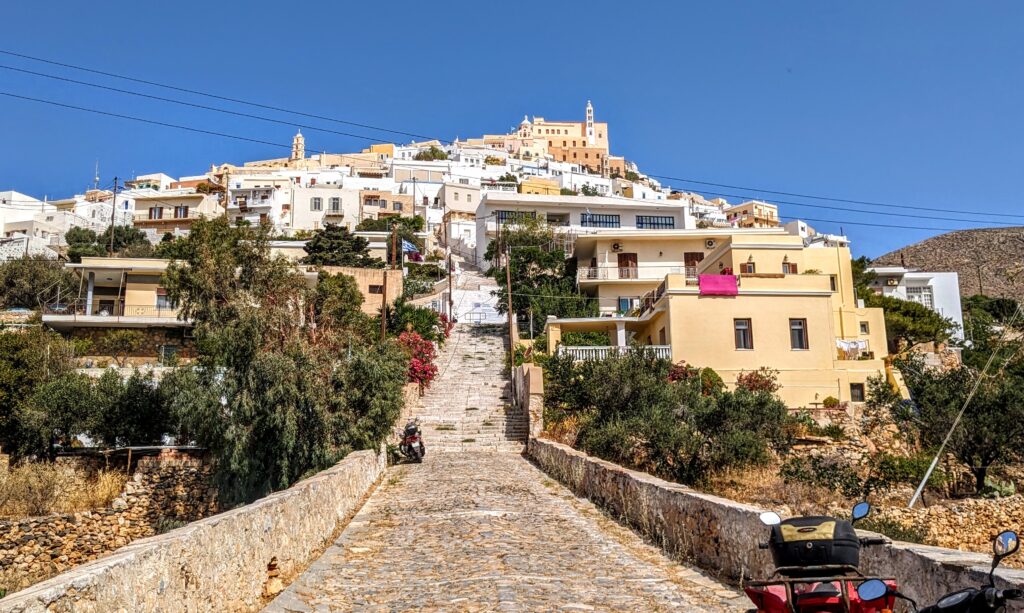
I’ve got more climbing to do!
About 45 minutes later I got to the church!
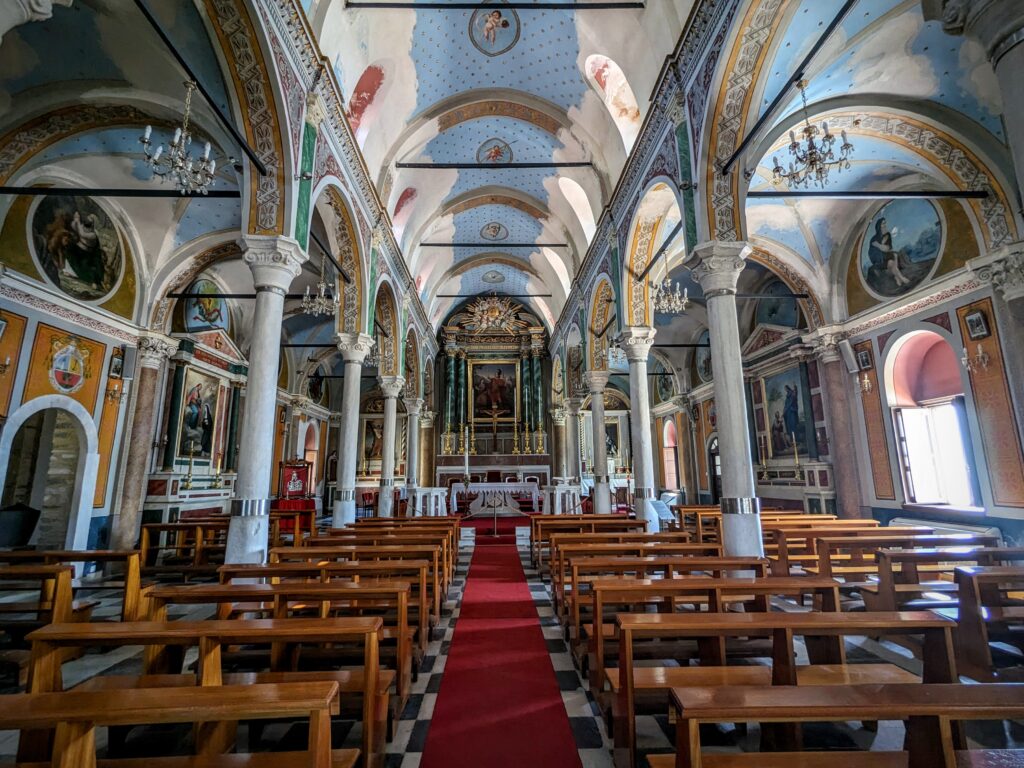
I was so thankful for the sanctuary! It was relatively cool inside the church and I had it to myself to cool down, explore, genuflect before the alter and light a candle to those loved ones who have passed.
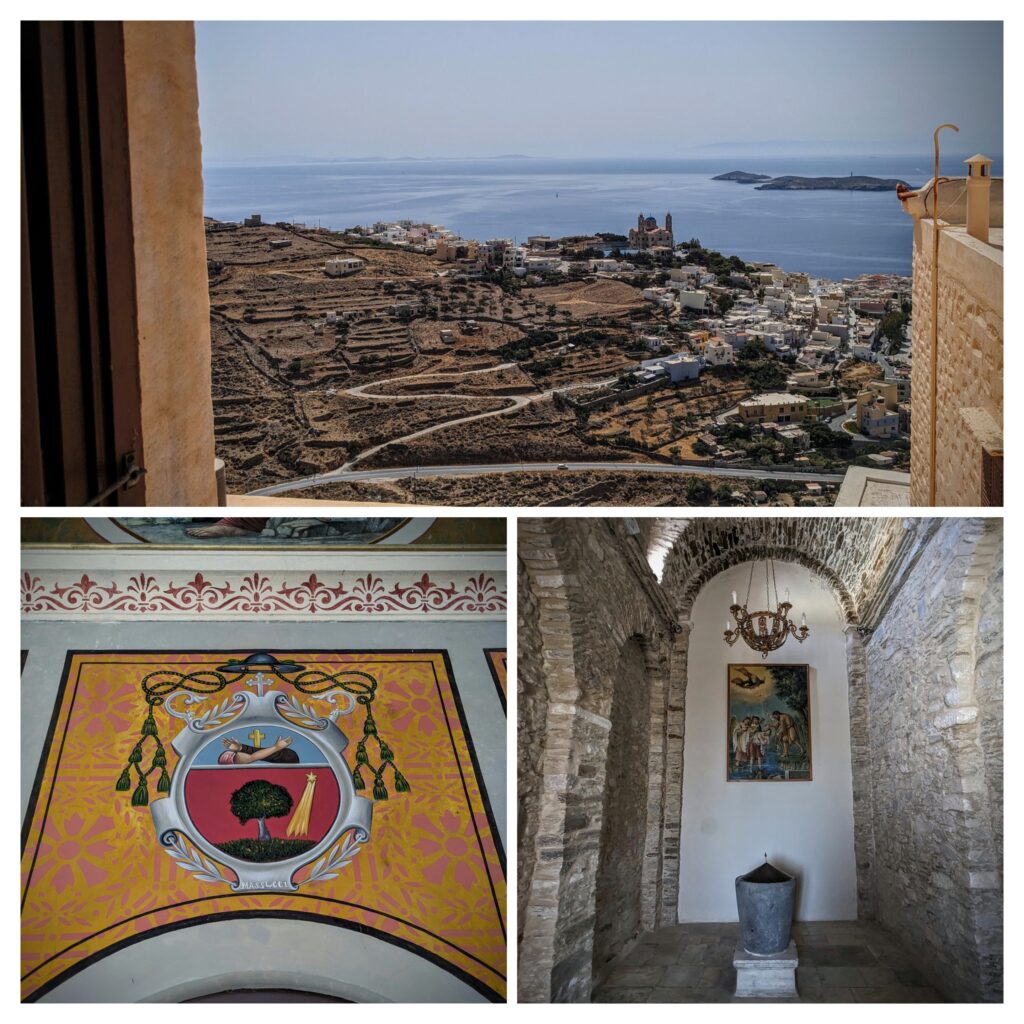
View out a window of the Cathedral towards the church on another hill, a true ‘coat of arms’ over a door frame revealed during restorations, the baptistry with a painting of John the Baptist of course!
I had a myriad of options to descend through the village back to the port! I wandered around randomly in the lanes, admiring the architecture.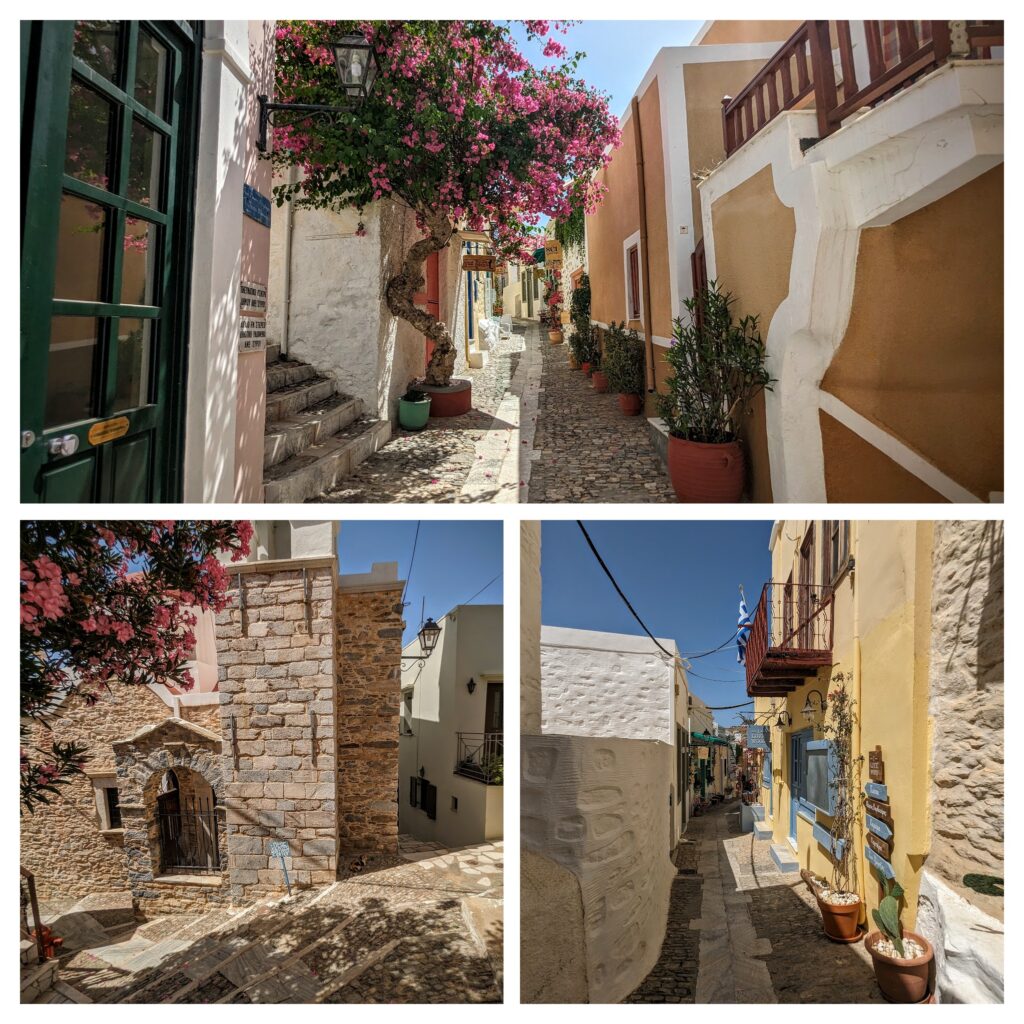 I stopped for a lemonade to rehydrate in the heat and had this great panorama!
I stopped for a lemonade to rehydrate in the heat and had this great panorama! I finally got back down and gratefully collapsed into the air conditioned room! I got cleaned up and we went out to restock with some groceries and wine for lunch.
I finally got back down and gratefully collapsed into the air conditioned room! I got cleaned up and we went out to restock with some groceries and wine for lunch.
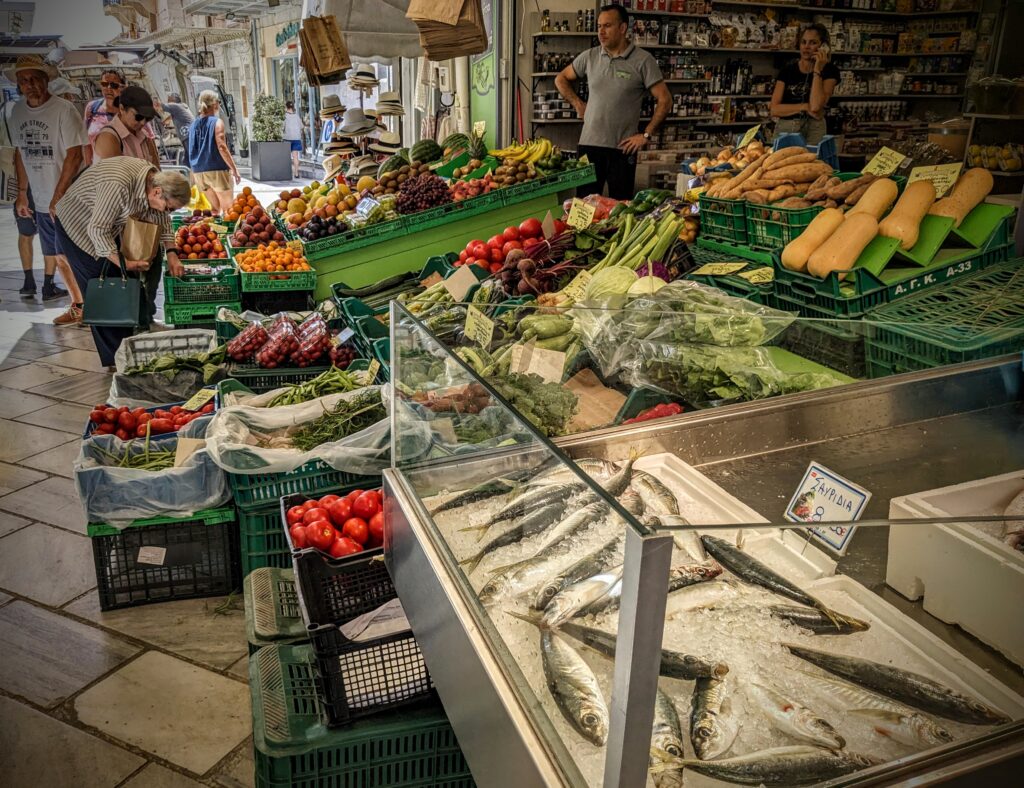
The small stores and vendors sell top quality food! No mega department stores, just specialized shops, baker, butcher, green grocer and gelateria!
June 3 Ermoupolis (Day 250)

The wooden sailing ship was heading out of port before…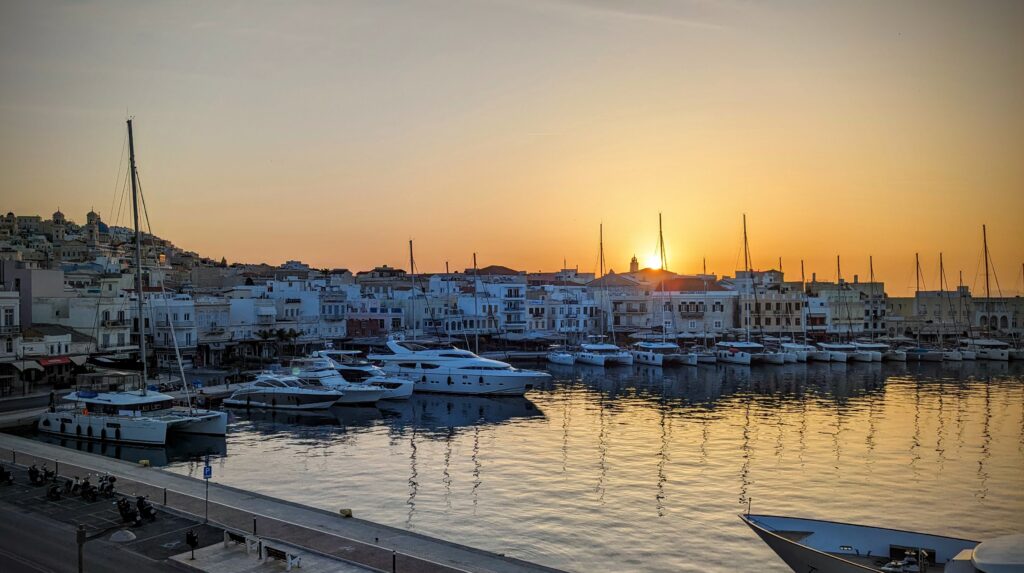 …the sun rose in the east. We took a stroll early, before the sun made it too hot to go out!
…the sun rose in the east. We took a stroll early, before the sun made it too hot to go out!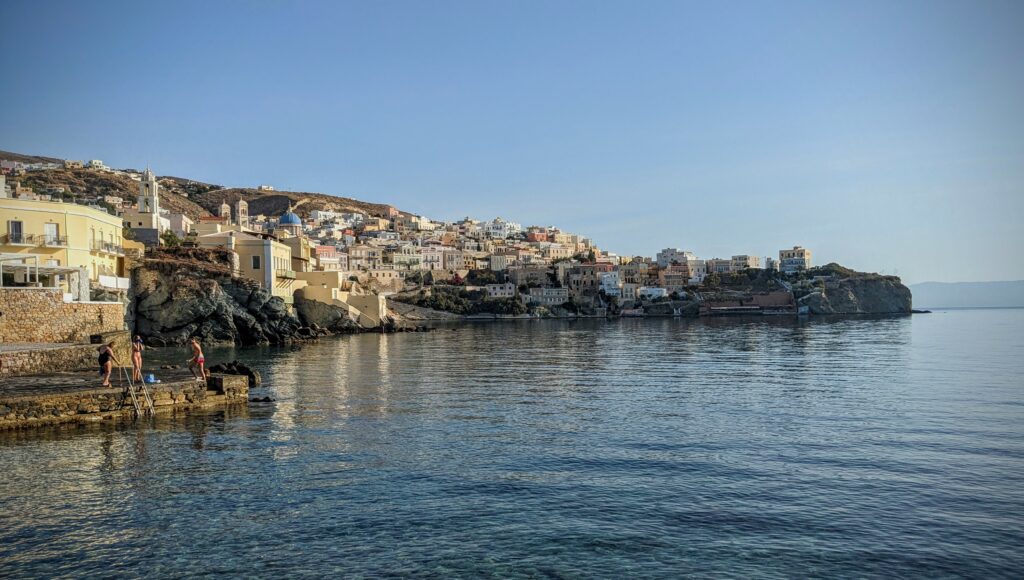 Some early morning bathers emerging from the sea.
Some early morning bathers emerging from the sea. Modern artwork outside classic Greek port authority buildings.
Modern artwork outside classic Greek port authority buildings.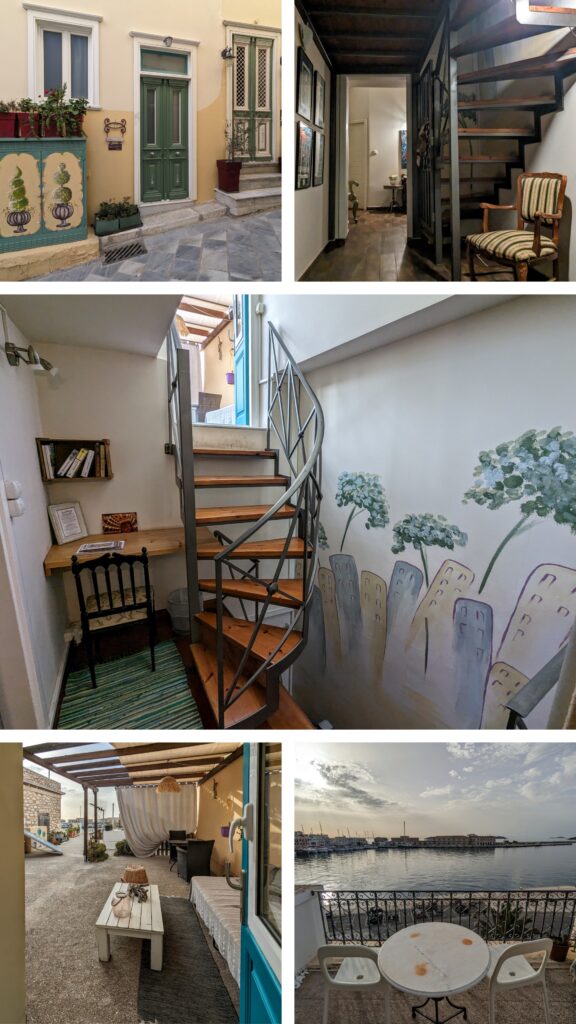 A chance to get some pictures of our lodging. A very narrow doorway opens onto the street, leading you up a few stairs into a hallway with a spiral staircase behind an iron gate. Our room is through the gate and up the spiral stairs. The landing with the small desk has 2 doorways, one to the bedroom and bath, the other to a spacious closet/dressing room with a small refrigerator and coffee maker, The stairs continue to the rooftop, opening to a spacious terrace, half of which is for our room exclusively, overlooking the harbor with the expensive boats!
A chance to get some pictures of our lodging. A very narrow doorway opens onto the street, leading you up a few stairs into a hallway with a spiral staircase behind an iron gate. Our room is through the gate and up the spiral stairs. The landing with the small desk has 2 doorways, one to the bedroom and bath, the other to a spacious closet/dressing room with a small refrigerator and coffee maker, The stairs continue to the rooftop, opening to a spacious terrace, half of which is for our room exclusively, overlooking the harbor with the expensive boats!
We took a long siesta in the heat of the day, enjoying the air conditioning in our room. We ventured out as it began to cool slightly in the evening.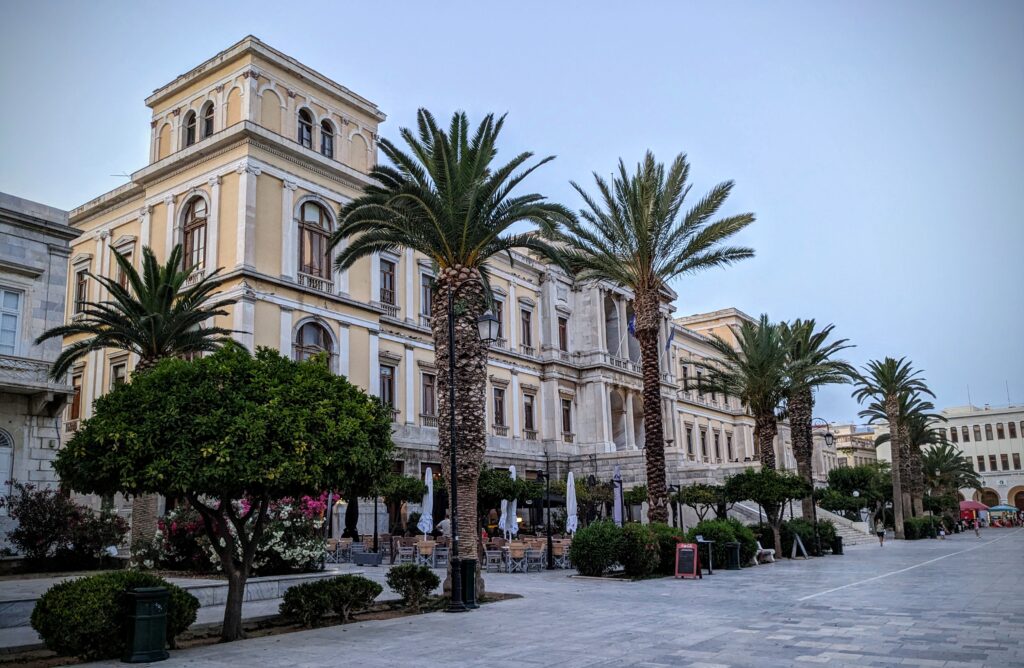 The city hall in the main town square.
The city hall in the main town square. One of the buildings displaying the neoclassical architecture the town is known for. Ermoupolis is a fairly new city, settled during the War of Independence in the 1820’s. Syros remained neutral during the war so it was a haven for many Greeks to settle relatively unscathed, especially those that had been successful merchants in the Ottoman Empire. For more pictures and descriptions of the town check out this website; The Mediterranean Traveller.
One of the buildings displaying the neoclassical architecture the town is known for. Ermoupolis is a fairly new city, settled during the War of Independence in the 1820’s. Syros remained neutral during the war so it was a haven for many Greeks to settle relatively unscathed, especially those that had been successful merchants in the Ottoman Empire. For more pictures and descriptions of the town check out this website; The Mediterranean Traveller.
 We climbed some stairs and steep roads to reach this church bathed in lights.
We climbed some stairs and steep roads to reach this church bathed in lights. And back at the harbor the boats of last night have been replaced with more, some even bigger and more luxurious!
And back at the harbor the boats of last night have been replaced with more, some even bigger and more luxurious!

 First off she explained the propensity of headless, armless statues! Wear and tear of course, the neck and arms being weak points in sculpture, easily fractured, and the fact that they made the statues en masse, to be interchangeable! The heads were sculpted separately to match the subject, and the arms could be holding different objects; law books, scrolls, wreathes, etc.!
First off she explained the propensity of headless, armless statues! Wear and tear of course, the neck and arms being weak points in sculpture, easily fractured, and the fact that they made the statues en masse, to be interchangeable! The heads were sculpted separately to match the subject, and the arms could be holding different objects; law books, scrolls, wreathes, etc.! Another statue showing the insert for the appropriate head!
Another statue showing the insert for the appropriate head!




















 The
The 
 That was some interesting people watching!
That was some interesting people watching!



 I stopped for a lemonade to rehydrate in the heat and had this great panorama!
I stopped for a lemonade to rehydrate in the heat and had this great panorama! I finally got back down and gratefully collapsed into the air conditioned room! I got cleaned up and we went out to restock with some groceries and wine for lunch.
I finally got back down and gratefully collapsed into the air conditioned room! I got cleaned up and we went out to restock with some groceries and wine for lunch.

 …the sun rose in the east. We took a stroll early, before the sun made it too hot to go out!
…the sun rose in the east. We took a stroll early, before the sun made it too hot to go out! Some early morning bathers emerging from the sea.
Some early morning bathers emerging from the sea. Modern artwork outside classic Greek port authority buildings.
Modern artwork outside classic Greek port authority buildings. A chance to get some pictures of our lodging. A very narrow doorway opens onto the street, leading you up a few stairs into a hallway with a spiral staircase behind an iron gate. Our room is through the gate and up the spiral stairs. The landing with the small desk has 2 doorways, one to the bedroom and bath, the other to a spacious closet/dressing room with a small refrigerator and coffee maker, The stairs continue to the rooftop, opening to a spacious terrace, half of which is for our room exclusively, overlooking the harbor with the expensive boats!
A chance to get some pictures of our lodging. A very narrow doorway opens onto the street, leading you up a few stairs into a hallway with a spiral staircase behind an iron gate. Our room is through the gate and up the spiral stairs. The landing with the small desk has 2 doorways, one to the bedroom and bath, the other to a spacious closet/dressing room with a small refrigerator and coffee maker, The stairs continue to the rooftop, opening to a spacious terrace, half of which is for our room exclusively, overlooking the harbor with the expensive boats! The city hall in the main town square.
The city hall in the main town square. One of the buildings displaying the neoclassical architecture the town is known for. Ermoupolis is a fairly new city, settled during the War of Independence in the 1820’s. Syros remained neutral during the war so it was a haven for many Greeks to settle relatively unscathed, especially those that had been successful merchants in the Ottoman Empire. For more pictures and descriptions of the town check out this website;
One of the buildings displaying the neoclassical architecture the town is known for. Ermoupolis is a fairly new city, settled during the War of Independence in the 1820’s. Syros remained neutral during the war so it was a haven for many Greeks to settle relatively unscathed, especially those that had been successful merchants in the Ottoman Empire. For more pictures and descriptions of the town check out this website;  We climbed some stairs and steep roads to reach this church bathed in lights.
We climbed some stairs and steep roads to reach this church bathed in lights. And back at the harbor the boats of last night have been replaced with more, some even bigger and more luxurious!
And back at the harbor the boats of last night have been replaced with more, some even bigger and more luxurious!